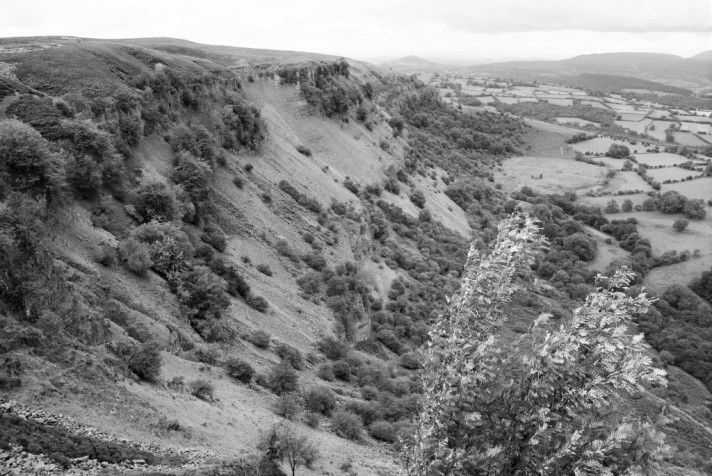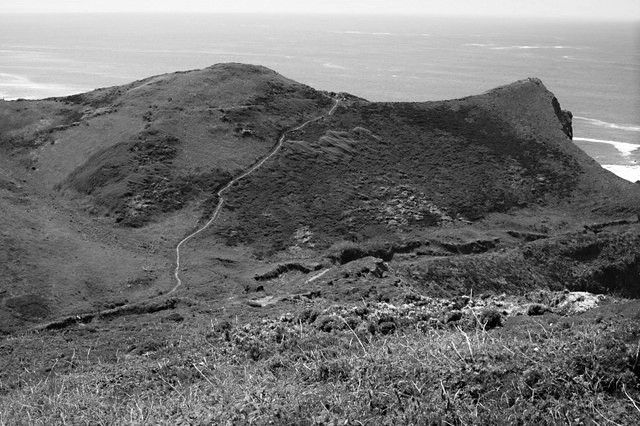
I have written about this place quite negatively in the past, focussing on the concrete square boxes that constitute architecture instead of looking as to what makes this section of landscape and coastpath so spectacularly beautiful in the extreme. Maybe it is because I associate the place with the dark remembered visits with my dysfunctional, unhappy family in the early 1970’s.
Somethings, I suppose, can’t help but linger in the memory…
Rediscovering the coastline, footpaths and narrow sunken lanes has been for me, a revelation, enabling me to cast aside my clouded memories and find a lightness and expanse to a landscape and town I’d often only associated with a grey dullness, tainted with bickering, alcohol infused unhappy parents. I never appreciated how exhilarating and breathtaking this stretch was before now and is something I shall never taint again.
Taking the winding lane opposite the blighted (sorry, force of habit), wonderful car park I crossed the road making my way from the town and out to the church. The herringbone patterned stone hedgerows (or Curzyway in the local parlance) are a unique feature to this part of North Cornwall, and throughout this walk I was to brush against an abundance of sweet-smelling flora; Sea and Pink Campion, coconut scented Gorse, Foxglove, Valerian with its sweet pungent aroma, Common Toadflax, Bramble, May Blossom, Willowherb, Sheep’s Bit and Smooth Hawks-beard. Rounding the bend in the road, the parish church of St Materiana stands sentry in splendid isolation where it has guarded the headland from around 1080, its late Norman tower, squat, square and standing strong against all that the Atlantic can hurl at it. A beacon and waymarker to shipping, fishermen and walkers alike through the centuries. I walked over a ‘Cornish Stile’ comprising a stone cattle-grid and a coffin rest in the centre and I was immediately hit by a sense of peaceful solitude; only the combined sounds of the sea, Skylark birdsong and the distant ‘chugga-chugga’ of a diesel engine hidden behind field walls broke the otherwise immaculate silence.
Laid out before me was the true, undisputable history of Tintagel; not the legend of ‘Arthur’ imagined in the crumbling walls on the next headland over, but the real people who cultivated the surrounding landscapes, hauled the rocks from the fields, built the settlements and kept the town breathing through 1,500 years of life.
After a walk around the churchyard and watching an early Spring migrant, a Swallow, taking nesting refuge in the church porch, I made my way right and continued on towards the island and its castle ramparts, taking care not to get too close to the destabilized cliff edges riddled with crumbling slate quarry workings. Adjacent to this section of sublime coastpath are accessible, rocky outcrops of Devonian Slates (about 370million years old) These rocks and those of the fortified island have been disturbed, crumbled, folded and faulted and consequently the Geological time relationships between the Slates, Tuffs and Lavas of the Tintagel Volcanic Formation are jumbled and mixed in with one another and misfiled. As I continued on towards the causeway and the ruined castle, the path changed in difficulty becoming steeper and narrower and is not for the nervous, skirting near vertical drops.
Throwing caution to the wind as this was a day of atonement, I retraced my steps those darker times, and decided on entering the castle (for a charge not too dissimilar to the steepness of the cliffpath) but it was well worth it. Despite the claims of an Arthurian connection, the castle, or the remains of the castle we see laid out before us, is mostly of an 11th & 12th Century Norman origin with a few 6th Century buildings (known as the ‘northern ruins’) In Cornish Tintagel (Tyn-tagel) refers to a fortress of the narrow entrance. The ruined monastery dates from around 500 AD. Which is contemporary with the church across the headland.
The steps down and along to the island must be treacherous on damper, wetter days but under that day’s early April sun the warmth on my face urged me on, filing the memory of the recent winter months deep within and rediscovering the excitement of my childhood exploration, before adults tore it away and suppressed it. When I reached the top of the island, passing through the ruins on the way, exploring the long dead rooms and looking back along the castle’s isolation, my true reward was to be the unbroken, panoramic view of the flat, open ocean and stepped headlands down to the west.
Leaving the island after an hour’s exploration I headed down through the narrow, well-walked paths to Tintagel Haven which once provided sheltered anchorage for the export of Tin, Slate and imports of Coal, Timber and everyday goods. Yet maybe the most surprising trading commodity has to be the Wine and Olive Oil, imported from the Mediterranean and the Byzantine Empire. Even now archaeological digs on the island and surrounding settlements will unearth fragments of Byzantium pottery from Millennia ago. A redundant Whim, still in position above the beach, was part of the winch that was used to haul Slates and Tin Ore down to the ships berthed below in the safety of the harbour, but now sits crumpled and crumbling, abandoned to the elements; an apt metaphor that everything we see is temporary, there is no permanence – everything changes. I carried on along the winding, sea-sprayed paths above the beach and made my way across the wooden boardwalk that crosses the narrow fast flowing stream, running down the hill before cascading into a small waterfall, onto the rocky shores below.
The two caves that stand in the island’s towering cliff-face reflect much of the place’s legend and fact and add to the sense of atmosphere that sits heavy in the haven. The smaller of the two was excavated by hand in the Mid-19th century to locate seams of copper bearing ore, and though worked for several years failed to prove profitable so it was left to the elements and natures speedy reclaim. The larger though is more well-known and immediately transports you back into the myths and legends, being called ‘Merlin’s Cave’ after many references made to it in Arthurian stories. Now though, just in case any visitors should be mistaken of their whereabouts, English Heritage in their infinite, caretakerly wisdom have commissioned a large ‘Merlin-like’ relief to be carved into the rock-face unwittingly turning a stunning, natural haven into the beginnings of a glorified Arthurian Theme Park. Admittedly the actual work is pretty good and carved quite beautifully, but really… Not in this wonderfully evocative setting please? Just sell it with the other ‘New-Age’ tat up in some of the souvenir shops in the town.
A short walk up the valley, past the crumbling light green, coarse-grained slate and the warning of potential rockfalls, stands a small café and toilets and a steep path back to town. I only mention it to change the subject from English Heritage’s rock graffiti.
With that in mind I took to the steps and ascended the path out of the haven, leaving the carving and castle behind me and headed towards Barras Nose, its crumbling, spectacular promontory acting as a refuge. The geology here, for a self-confessed geek like me is truly fascinating with a mixture of cleaved, weathered rock types; Slates, Siltstones, with Volcanic Pillow Lavas and Tuff at its furthest reachable point, and is a great walking route, both easy to navigate and quite spectacular in its view yet treacherous underfoot in damp, wet weather. From here I followed the path that leads on towards Willapark (not to be confused with Boscastle’s Willapark a few miles up the coast – as in the Cornish language Willapark means ‘enclosure with a view’ so there are a couple of these place names in the Duchy). Passing above Barras Cove and Gullastem, I continued on, away from the old infected childhood memories stopping at a kissing gate, and brought back into the present, I am taken in by the constant chattering of the wonderful Skylarks and turn, looking back down to the island and on to the surrounding landscape. It’s then that I realised that, like Pavlov’s experiment I have mistakenly associated this entire place with a memory: a reminder of things past. So it’s not Tintagel that affects me in my loathing of the place but the ‘ringing bell’ left in memory by my parent’s that has remained with me.
Walking towards Willapark I could make out the ghost lines of the Iron-Age settlement laying in shallow relief across the open landscapes, most have been levelled and ploughed flat yet still the feint outlines remain. Just offshore, to the West, are The Little Sisters and Lye Rock, where on 20th December 1893 The Ion, carrying coal from Wales to Trinidad struck the jagged, razored rocks. Four local men braved the seas to save 9 sailors, but 3 others drowned including the cabin boy, Domenico Catanese, who’s grave sits in the quiet churchyard of St. Materiana, back at this walks beginning.
Facing East now I headed along the lower path around the small headland above Bossiney Haven. The steep, slippery steps heading down (and on outwards) to the Haven Valley are uneven and difficult underfoot, even when dry, yet the beach below is secluded yet popular with bathers, Kayakers and Cave explorer’s – and just as enjoyable is the fact that there is little in the way of mobile phone signal. Bliss…
Continuing on, I trip-trapped over a small wooden bridge, the steady flow of clean-looking, clear water reflected the sun’s rays into rivulets of silver. A four-way marker shows the path to the near empty beach, a return path to the main road to Tintagel via Bossiney Village, and the forward facing path to Boscastle. I chose the route less-travelled; sixty or so steep steps that lead out to the narrow valley to reach Bossiney Cliffs which made me realise why it didn’t look too well-trod so, by now, my legs were screaming for me to stop but to do that would mean starting again, so I carried on, a martyr to the lactic acid building in my calves. When at the far side, above the valley, I looked back on the route I’d taken and picked out the appropriately named ‘Elephant Rock’ stopping to take long, chilled drafts from my water-bottle and taking even longer, deep breaths.
This small journey was nearly over for today, coming to the returning point of the route, needing to get back to the car and then home again. Yet the feeling of closure within my conflicted relationship with my parents seems, at long last, to be careering to an end. Now that I have started to address the past, take responsibility and to try to understand what happened, instead of apportioning blame to them both. This walk along the damaged memories has helped me more than I expected it to and has come some way towards helping me reach my journey’s end.
Just over that hill now and I should be there.
Sam Josh Thomas










